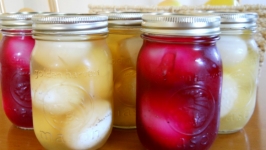Ode To: Mayonnaise
An Upstate resident shares the history of local staple Duke's Mayonnaise while recalling her own complicated relationship with the condiment.
Duke’s Mayonnaise, a History
1912—Greenville, SC. At a picnic or a neighbor’s house, at a church social or a tea room or because she bought it out of curiosity herself, Eugenia Duke tastes for the first time commercially available mayonnaise from a jar. She is 34 years old, the mother of an only daughter, owner of an entrepreneurial mind. She knows she can do better.
1917—In her kitchen on Manly Street, Eugenia Duke tests her recipe. Her husband tries sandwich after sandwich: deviled ham and egg salad, pimiento cheese. Each one, he says, is wonderful, his handsome three-piece suit straining at the seams. It’s the mayonnaise that makes it. She writes the recipe on the back on an envelope: lots of egg yolks, no sugar of any kind, the exact proportions secret, unchanged unto this day.
1918—Spring, the end of the war. At Camp Sevier near Taylors SC, the soldiers line up at Eugenia Duke’s sandwich cart, fields of boys in fatigues, their hats in their hands, their dimes warm from their pockets. In one day, Eugenia Duke sells 10,000 sandwiches, made with her mayonnaise, to these boys about to head into the trenches. They are hungry for a taste of home.
1925—Eugenia Duke stands in the empty Markley Carriage paint shop on the banks of the Reedy River. Everything around her is growing, booming: new neighborhoods, new streetcars, the Hugenot Mill next door now makes underwear sold all across the country. And her mayonnaise is sold in supermarkets, her sandwiches in drugstores, she can no longer make do in her kitchen on Manly Street. She looks down at the churning falls, pinkish today, the union suits next door must be red. She turns to her husband who turns to the man and tells him that they’ll take it. Her first factory.
1929—Maybe it all got too big. Maybe there was more than she could handle by herself, or simply the opportunity presented itself to move on. Her daughter was gone to California, and had a daughter of her own. Eugenia Duke sold her mayonnaise factory to C.F. Sauer, her recipes to her bookkeeper, and she and her husband left Greenville on the train for the San Francisco Bay: another war, another sandwich company called Dutchess. She was good at making things, making money, not keeping it.
My Mayonnaise, An Evolution
1977—At our kitchen table, some-time midsummer, I watch my father spoon a shimmering dollop of mayonnaise onto a slab of lime green Jello. The Jello is dessert, for god’s sake, meant to be eaten with Cool Whip or even ice cream. Thinking back, it feels as though I’ve watched something dark and horrifying lurch forth from his temperament. Thinking back, it’s like how can he like me, and like that at the same time?
1980—Caroline Cooke’s house, after school. Caroline’s mother, who still has beautiful frosted Farrah Fawcett hair, asks if we would like a grilled cheese sandwich. Of course we would. She delivers them to the backyard swingset, white bread made gold, cut on the diagonal perfection. But biting in, there is something white and oozing sourly here, something not cheese and bread, something wrong. When I ask, it’s mayonnaise. The first grilled cheese sandwich undevoured.
1986—Middle school provides a thousand ways to improve myself. In Seventeen magazine, I read an article about how to find beauty in common kitchen ingredients: egg whites beaten, spread and dried on my face, coins of cucumbers across my eyes, avocados, honey. I wrap my hand in plastic wrap and apply fistfuls of mayonnaise straight from the jar to my waist-length hair, the promise being moisture and gloss, after twenty minutes and a shampoo, the mane of a colt. My mother finds me in the bathroom, wearing nothing but a turban of cellophane and stinking. She cannot stop laughing, and this becomes the first of many times she says, Where the hell did you read that, Seventeen magazine?
1990—Tomato pie. Served to me by a friend’s mother, born and raised in Chester, SC. I have never eaten anything so wonderful as a tomato pie. I watch her make it, writing the list of layers on the back of an envelope: tomatoes, onions, mayonnaise, cheese. I steal this recipe, tinker with it a little bit, call it my own. I make tomato pie in college. I make it as a newlywed. I make it better than my aunt, my mother, my California friends who try to use low fat salad dressing instead of mayonnaise. I feel culinary pride, this is the turning point in my relationship with mayonnaise. It’s no longer merely condiment or application, you can do things with this stuff that nobody would ever suspect. A secret.
1999—As a mother, a wife, a cook and a writer, I move to Green-ville, SC, back to the south. I discover many things anew: pimiento cheese, benedictine spread, the perfect chicken salad. I discover Duke’s mayonnaise, not where it’s always been, on the grocery store shelves, but in a list of Saveur magazine’s top 100 things they love. It’s still made here, in Mauldin, at the rate of 240 jars a minute, and I have that moment of shame and satisfaction where someone from far, far away has shined a light into my own backyard and found a treasure. The ritualistic phrase, “but no mayonnaise” finally disappears from my vocabulary.






